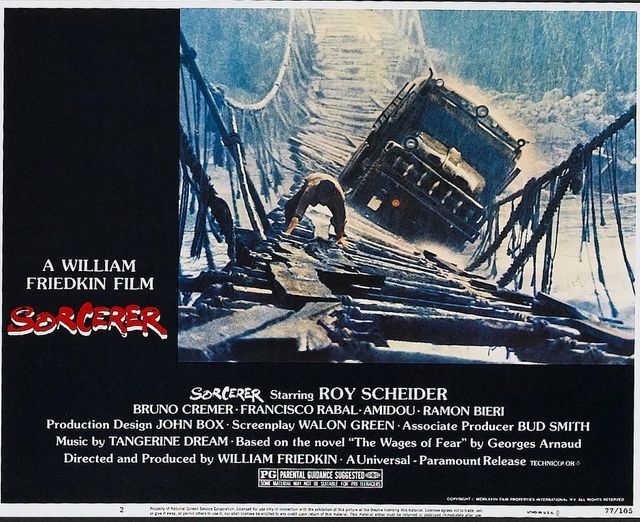Panned and largely ignored on its initial release (although
it was up against Star Wars at the Box Office), Sorcerer is a beautiful, brutal
and unbearably tense film.
The first half an hour or so is set up, where we learn
something of the back story of Nilo (Francisco Rabal), a hitman who pulls off a
killing in Mexico, Kassem (Amidou), an Arab terrorist who has just set off a
bomb in the middle of Jerusalem, Serrano (Bruno Cremer), a crooked French
banker, and gangster Scanlon (Roy Scheider) who has to flee after robbing a
church and killing a priest whose brother is in the mob. All four find
themselves in the South American town of Porvenir, a dismal place where, to quote
Hunter S. Thompson, "men sweat 24 hours a day". With funds low and
desperation high, their only way out is to drive trucks full of highly unstable
Nitro-glycerine over treacherous mountain dirt roads to help put out a fire at
an American owned oil well.
The film takes the same source (the novel Le salaire de la
peur) as the 1953 French thriller The Wages of Fear. However, director William
Friedkin, who denied this was a remake of the earlier film, stamps his own
personal style on to the material with a mix of the documentary realism and
stylised imagery seen in The Exorcist.
There is shaky handheld close-up camera work, which bring us
right into the chaos and confusion, but Friedkin also seems to anthropomorphise
objects. The jungle sometimes feels like a malevolent sentient being, with
vines and branches leaping out from nowhere to attack the trucks, and, when
viewed from the front with their headlamps glowing in the dark like eyes, the
trucks almost have a life of their own, like beasts that the men are riding on
an ancient mythical quest. Friedkin is also comfortable with regular passages
of non-English dialogue, or even long passages of no dialogue whatsoever, using
images to tell the story.
Visually the palette is rich, with blue skies and green jungle
backdrops contrasted with fiery orange explosions and the ubiquitous brown mud.
Sound also plays a big part in the film, from Tangerine Dream's creepy, gloomy
score to the contrasting scenes of noisy chaotic action, and total silence.
The brilliant direction is backed up by a brilliant cast,
headed by Roy Scheider, who, despite playing a mafia hitman, brings the same
likeable and identifiable everyman quality to his role that he did in Jaws.
From the rest of the cast Bruno Cremer makes the most impact, as the suave
playboy thrown from a world of luxury and money into one of sweat, toil,
desperation and poverty. These are people trapped by location and circumstance
of their own making.
The other character is that of the landscape itself, which
suffers as much as any of the people, both from the trucks ploughing through
trees and churning up mud, and the fires and pollution of big business.

No comments:
Post a Comment